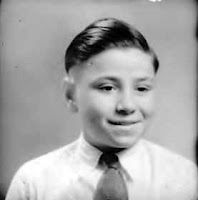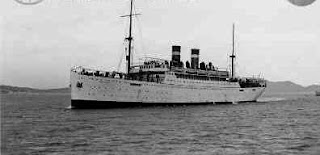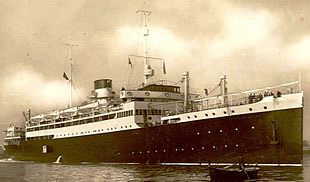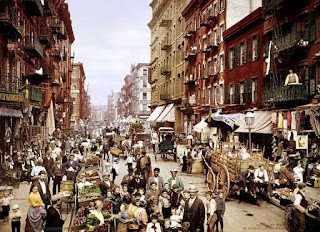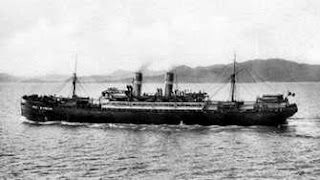I think that these lyrics can easily be applied to not only lovers...though clearly that's the intent, but in a sense, they also describe what happens in a family when someone leaves whether by choice or circumstance. These words can easily be used to tell the story of a family's migration to make a better life, as well as the loneliness and maybe even a little desperation of those left behind.....
So far away
Doesn't anybody stay in one place anymore
It would be so fine to see your face at my door
Doesn't help to know you're just time away
Long ago I reached for you and there you stood
Holding you again could only do me good
Oh I wish I could
But you're so far away
One more song about moving along the highway
Can't say much of anything that's new
If I could only work this life out my way
I'd rather spend it being close to you
But you're so far away....
I can imagine that there was a similar lament made by many of the women in my family left behind in Italy with their children... while the men were off to America, seeking (and hoping to find) work. I'm certain my great-grandmothers, Elisabetta Poppa and Antonia DiFoggio, as well as my grandmother, Theresa Poppa all knew and recognized the necessity... but I doubt that having that knowledge lessened the fear and anxiety that these brave women endured.
When their time came to leave the only home they had ever known to this point, for an unfamiliar country... where they would somehow have to adapt to a new way of life, when they didn't speak or understand the language or… knew few if any people living there...it must have been a lonely, frightening and yet somehow an exciting time for them. Naturally, they would miss their friends and any family left behind... along with a way of life that was comforting and safe. The song's lyrics seem to capture that sentiment...
Traveling around sure gets me down and lonely
Nothing else to do but close my mind
I sure hope the road don't come to own me
There's so many dreams I've yet to find
But you're so far away
Doesn't anybody stay in one place anymore
It would be so fine to see your face at my door
Doesn't help to know you're so far away.
Nothing else to do but close my mind
I sure hope the road don't come to own me
There's so many dreams I've yet to find
But you're so far away
Doesn't anybody stay in one place anymore
It would be so fine to see your face at my door
Doesn't help to know you're so far away.
Many other brave women in my family experienced the same thing...this post, however, will concentrate on three of these special ladies.
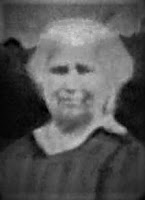 |
| Elisabetta Poppa nee Branca |
In 1906 Elisabetta was 42, when her husband Fedele left for America. She remained at home attending to their three youngest children all between the ages of ten and four. Their eldest son, Leonardo was married with a family of his own, while fifteen-year-old Isidoro was off to America with his father. I have not yet found any of the ship manifests for Fedele and Isidoro's return voyage to Italy. An educated guess, however, would suggest that father and son were back home at some point in 1909 based on Isidoro's pending marriage in 1910.
On March 5,1913, Fedele, Elisabetta, and their three younger children, Marietta, Grazia (Grace) and Agostino set sail on the SS Venetia. They arrived in the United States on March 21. Eventually, the entire family would settle in Bridgeport, Connecticut.
Elisabetta would outlive her husband by 14 years and the loss of her son, Isidoro by 16. She would die on November 24, 1939, from pneumonia following a fractured femur at the age of 75.
ANTONIA BORRELLI
My other paternal great-grandmother, Antonia Borrelli was born in Orsara di Puglia, Foggia, Italy, on June 13, 1862. Her father, Nicola was 27 and her mother, Maria Acquaviva was 22. She and my paternal great-grandfather, Leonardo DiFoggio married in their hometown in 1885. Antonia was 23 and Leonardo was 25. During their 61-year marriage, there were five children born to them between 1886 and 1904... Theresa (1886), Michael (1888), Rocco (1893), Lucy (1895) and Grace (1904).
In 1899 Antonia was 37, when Leonardo went to America for the first time. She remained at home to raise their four children. The eldest was my paternal grandmother, Theresa...age 13 at that time and the youngest child... great-aunt, Lucy was four. I have not found any passenger lists or ship manifests that mark Leonardo's return to Italy. However, the birth of his daughter Grace places him in Orsara, probably between 1902 and 1903. I have not been able to determine whether he went back to the United States prior to his permanent emigration.
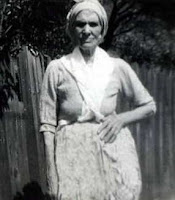 |
| Antonia DiFoggia nee Borrelli abt 1943 |
In 1899 Antonia was 37, when Leonardo went to America for the first time. She remained at home to raise their four children. The eldest was my paternal grandmother, Theresa...age 13 at that time and the youngest child... great-aunt, Lucy was four. I have not found any passenger lists or ship manifests that mark Leonardo's return to Italy. However, the birth of his daughter Grace places him in Orsara, probably between 1902 and 1903. I have not been able to determine whether he went back to the United States prior to his permanent emigration.
In 1920, Leonardo, Antonia and their 16-year-old daughter Grace left Italy for America on the SS Taormina. They would join the rest of their family, Theresa, Michele (Michael), Rocco and Lucy...all married with families of their own at this point and eventually settle down in Chicago, Illinois.
Antonia predeceased her husband by 3 years. She died on December 28,1946 at the age of 84 from acute dilatation of the heart.
Antonia predeceased her husband by 3 years. She died on December 28,1946 at the age of 84 from acute dilatation of the heart.
THERESA DIFOGGIO
 |
| Theresa Poppa nee DeFoggia abt 1925 |
In 1912 or 1913, depending on what document you read... Isidoro, Theresa and their two-year-old son, Fedele would board the SS Sant' Anna for America. They would temporarily live in New Rochelle, New York. While there, Theresa would give birth to a daughter, Elizabeth sometime between 1912 and 1913. Sadly, the tiny infant would die within that same year. Eventually, there would be six more children...Antoinette (1914), Rocco (1916), Leonard (1918), Elizabeth (1920), Agostino (1922) and Mary (1923). Like her older sister, Elizabeth...Mary would not survive infancy and would pass on in late 1924.
Once settled in the United States, the family would split their time between Bridgeport, Connecticut and Chicago, Illinois. Isidoro died from tuberculosis on August 18,1923 at the age of 32 in Bridgeport. Theresa and her children moved back to Chicago, shortly thereafter, to be nearer her parents and siblings. There would however, be many trips back to Bridgeport over the years for visits and family occasions. Theresa and the kids, lived on DeKalb Street (n/k/a Bowler) in what is known as the Tri-Taylor Street neighborhood of Chicago. Although no one knew it then...they were living just across the street and down the block from some other very special people in my life...my maternal grandparents, Angelo and Mary DeLio and more importantly...a young girl named Mary (or Marilyn as she preferred), who would one day become my mother.
As a single parent in the early 1920s, Theresa took care of her family, as best she could...earning a living through what was called piecework. As the name implies, piecework was work done by the piece and paid for at a set rate per unit. My maternal grandmother, Mary taught Theresa how to tat. Tatting is a technique for handcrafting a particularly durable lace from a series of knots and loops and is made with the shuttle passing in, out and around a loop of thread wound around your hand to tie a simple set of knots, using cotton thread instead of yarn. Theresa honed the skills she acquired and sold her hand-tatted lace for several pennies a yard. Every little bit helped and even the boys at ages twelve, 8 and 7 also got odd jobs to help make ends meet.
Theresa would live another 35 years after Isidoro's passing. She died on December 19, 1958 at the age of 72 from a cerebral hemorrhage.
All of these ladies were kindhearted, loving women. All were the sole parent to their children at one time or another...created more out of necessity than design. They overcame more hardships than I could ever imagine going through. I never knew Elisabetta or Antonia. Memories of my grandmother, Theresa are fewer than I would like, as I was four-years-old when she died. I remember what she looked like and how tightly she would hug me, squeeze my hand... or wipe away the sticky, lemony juice, that ran down my chin from the Italian ices that my father would buy on visits to grandma's house. I also recall and cherish a handful of stories about her, too. I'm grateful for those memories, but I wish I had more of them. She is someone that will never be so far away from my heart.
Once settled in the United States, the family would split their time between Bridgeport, Connecticut and Chicago, Illinois. Isidoro died from tuberculosis on August 18,1923 at the age of 32 in Bridgeport. Theresa and her children moved back to Chicago, shortly thereafter, to be nearer her parents and siblings. There would however, be many trips back to Bridgeport over the years for visits and family occasions. Theresa and the kids, lived on DeKalb Street (n/k/a Bowler) in what is known as the Tri-Taylor Street neighborhood of Chicago. Although no one knew it then...they were living just across the street and down the block from some other very special people in my life...my maternal grandparents, Angelo and Mary DeLio and more importantly...a young girl named Mary (or Marilyn as she preferred), who would one day become my mother.
As a single parent in the early 1920s, Theresa took care of her family, as best she could...earning a living through what was called piecework. As the name implies, piecework was work done by the piece and paid for at a set rate per unit. My maternal grandmother, Mary taught Theresa how to tat. Tatting is a technique for handcrafting a particularly durable lace from a series of knots and loops and is made with the shuttle passing in, out and around a loop of thread wound around your hand to tie a simple set of knots, using cotton thread instead of yarn. Theresa honed the skills she acquired and sold her hand-tatted lace for several pennies a yard. Every little bit helped and even the boys at ages twelve, 8 and 7 also got odd jobs to help make ends meet.
Examples of tatting...a pin cushion cover and tea cozy made by my grandmother, Theresa Poppa.
Theresa would live another 35 years after Isidoro's passing. She died on December 19, 1958 at the age of 72 from a cerebral hemorrhage.
All of these ladies were kindhearted, loving women. All were the sole parent to their children at one time or another...created more out of necessity than design. They overcame more hardships than I could ever imagine going through. I never knew Elisabetta or Antonia. Memories of my grandmother, Theresa are fewer than I would like, as I was four-years-old when she died. I remember what she looked like and how tightly she would hug me, squeeze my hand... or wipe away the sticky, lemony juice, that ran down my chin from the Italian ices that my father would buy on visits to grandma's house. I also recall and cherish a handful of stories about her, too. I'm grateful for those memories, but I wish I had more of them. She is someone that will never be so far away from my heart.
 |
| My Family's Migration from Italy to the United States |











